Номер 14, страница 74 - гдз по английскому языку 11 класс учебник Афанасьева, Михеева
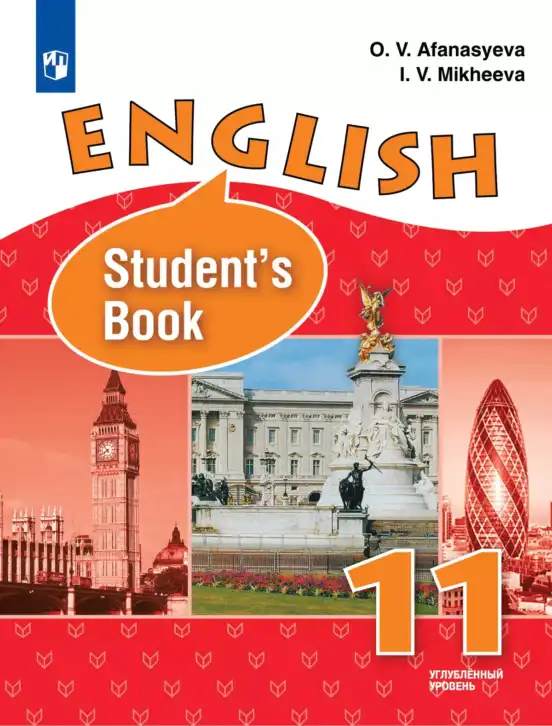
Авторы: Афанасьева О. В., Михеева И. В.
Тип: Student's book (Учебник)
Издательство: Просвещение
Год издания: 2014 - 2025
Уровень обучения: углублённый
Цвет обложки: белый, красный
ISBN: 978-5-09-034233-9
Популярные ГДЗ в 11 классе
Unit Two. Town and Its Architecture. Reading - номер 14, страница 74.
№14 (с. 74)
Условие. №14 (с. 74)
скриншот условия
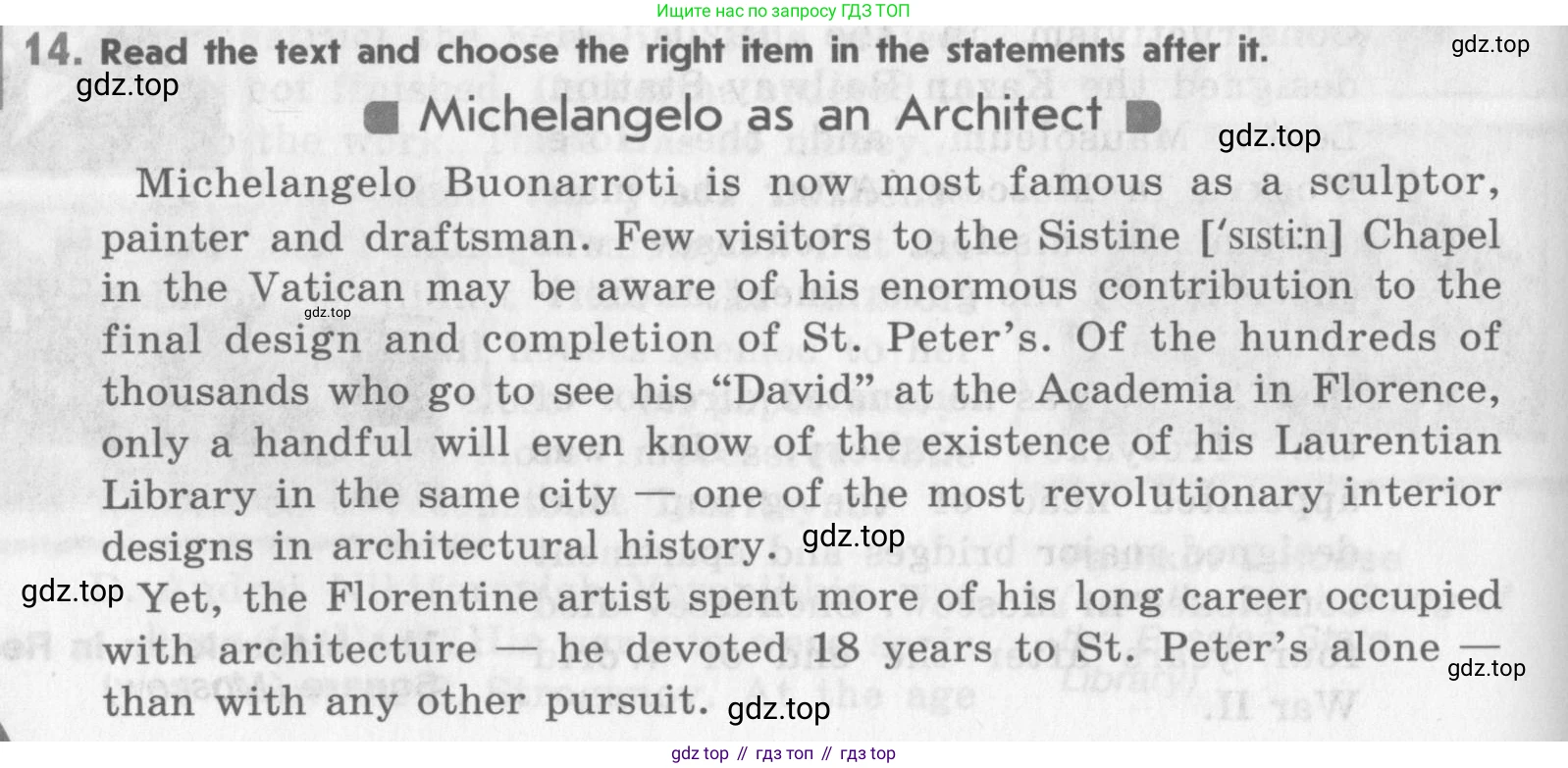
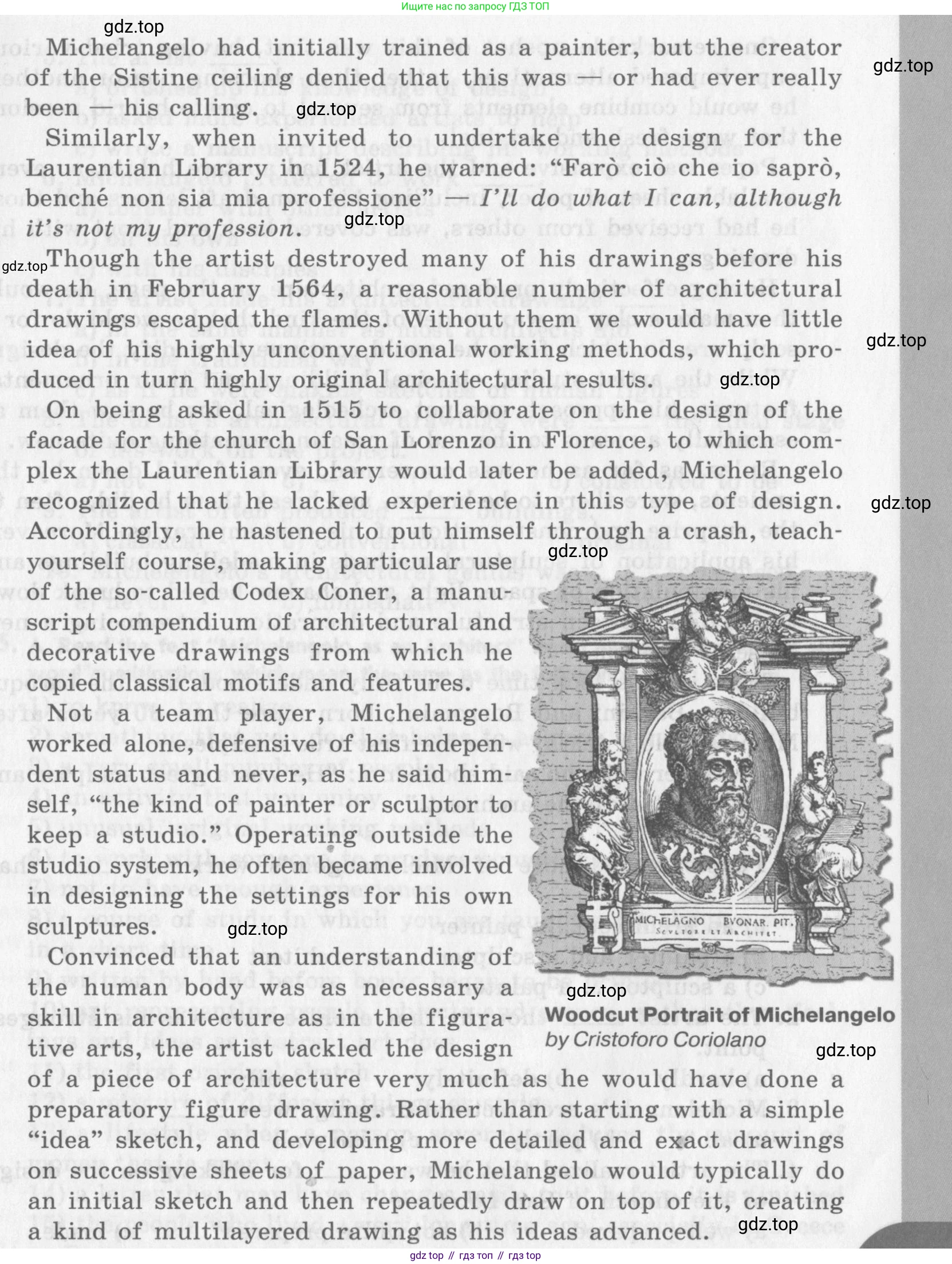
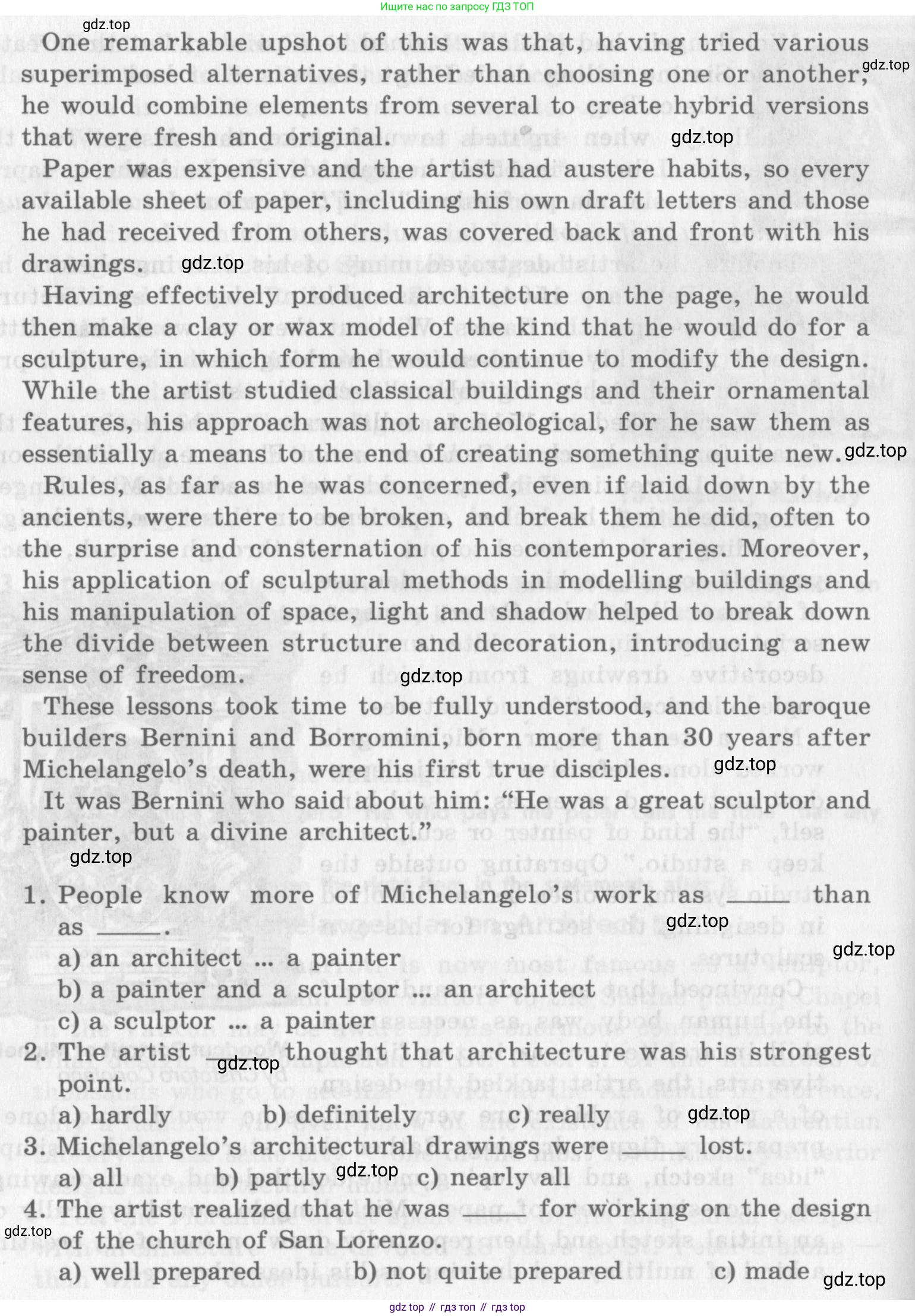
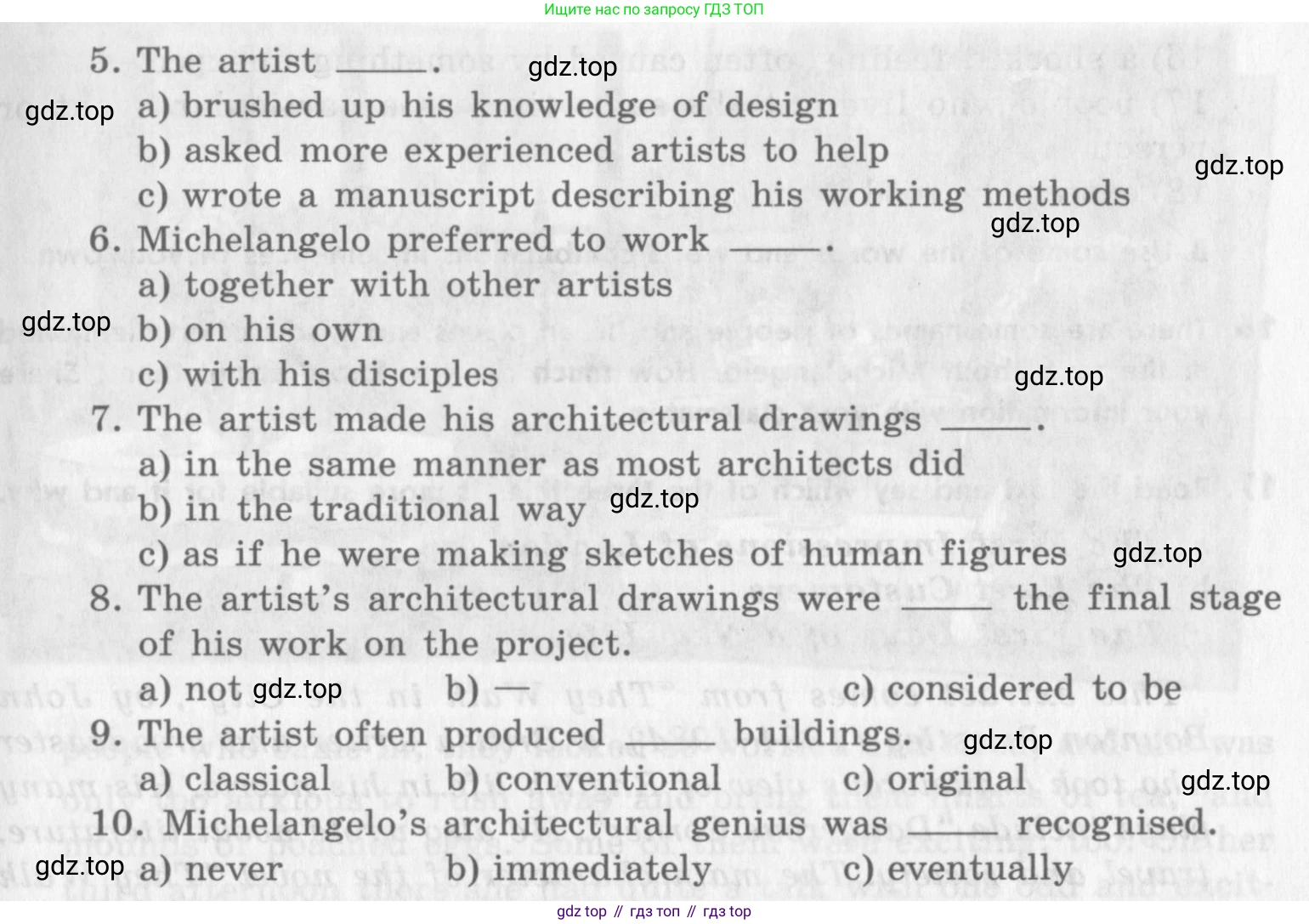
14. Read the text and choose the right item in the statements after it.
Michelangelo as an Architect
Michelangelo Buonarroti is now most famous as a sculptor, painter and draftsman. Few visitors to the Sistine [‘sɪstɪn] Chapel in the Vatican may be aware of his enormous contribution to the final design and completion of St. Peter’s. Of the hundreds of thousands who go to see his “David” at the Accademia in Florence, only a handful will even know of the existence of his Laurentian Library in the same city — one of the most revolutionary interior designs in architectural history.
Yet, the Florentine artist spent more of his long career occupied with architecture — he devoted 18 years to St. Peter’s alone — than with any other pursuit.
Michelangelo had initially trained as a painter, but the creator of the Sistine ceiling denied that this was — or had ever really been — his calling.
Similarly, when invited to undertake the design for the Laurentian Library in 1524, he warned: “Farò ciò che io saprò, benché non sia mia professione” — “I’ll do what I can, although it’s not my profession.”
Though the artist destroyed many of his drawings before his death in February 1564, a reasonable number of architectural drawings escaped the flames. Without them we would have little idea of his highly unconventional working methods, which produced in turn highly original architectural results.
On being asked in 1515 to collaborate on the design of the facade for the church of San Lorenzo in Florence, to which complex the Laurentian Library would later be added, Michelangelo recognized that he lacked experience in this type of design. Accordingly, he hastened to put himself through a crash, teach-yourself course, making particular use of the so-called Codex Coner, a manuscript compendium of architectural and decorative drawings from which he copied classical motifs and features.
Not a team player, Michelangelo worked alone, defensive of his independent status and never, as he said himself, “the kind of painter or sculptor who needs to keep a studio.” Operating outside a studio system, he often became involved in designing the settings for his own sculptures.
Woodcut Portrait of Michelangelo
by Cristoforo Coriolano
Convinced that an understanding of the human body was as necessary a skill in architecture as in the figurative arts, the artist tackled the design of a piece of architecture very much as he would have done a sculpture, preceding even an initial “idea” sketch, and developing more detailed and exact drawings on successive sheets of paper, Michelangelo would typically draw on top of it, creating a kind of multilayered drawing as his ideas advanced.
One remarkable upshot of this was that, having tried various superimposed alternatives, rather than choosing one or another, he would combine elements from several to create hybrid versions that were fresh and original.
Paper was expensive and the artist had austere habits, so every available sheet of paper, including his own draft letters and those he had received from others, was covered back and front with his drawings.
Having effectively produced architecture on the page, he would then make a clay or wax model of the kind that he would do for a sculpture, in which form he would continue to modify the design.
While the artist studied classical buildings and their ornamental features, his approach was not archeological, for he saw them as essentially a means to the end of creating something quite new.
Rules, as far as he was concerned with the ancients, were there to be broken, and break them he did, often to the surprise and consternation of his contemporaries. Moreover, his application of sculptural methods in modelling buildings and his manipulation of space, light and shadow helped to break down the divide between structure and decoration, introducing a new sense of freedom.
These lessons took time to be fully understood, and the baroque builders Bernini and Borromini, born more than 30 years after Michelangelo’s death, were his first true disciples.
It was Bernini who said about him: “He was a great sculptor and painter, but a divine architect.”
1. People know more of Michelangelo’s work as _______ than as _______.
a) an architect ... a painter
b) a painter and a sculptor ... an architect
c) a sculptor ... a painter
2. The artist _______ thought that architecture was his strongest point.
a) hardly b) definitely c) really
3. Michelangelo’s architectural drawings were _______ lost.
a) all b) partly c) nearly all
4. The artist realized that he was _______ for working on the design of the church of San Lorenzo.
a) well prepared b) not quite prepared c) made
5. The artist _______ .
a) brushed up his knowledge of design
b) asked more experienced artists to help
c) wrote a manuscript describing his working methods
6. Michelangelo preferred to work _______ .
a) together with other artists
b) on his own
c) with his disciples
7. The artist made his architectural drawings _______ .
a) in the same manner as most architects did
b) in the traditional way
c) as if he were making sketches of human figures
8. The artist’s architectural drawings were _______ the final stage of his work on the project.
a) not b) _______ c) considered to be
9. The artist often produced _______ buildings.
a) classical b) conventional c) original
10. Michelangelo’s architectural genius was _______ recognised.
a) never b) immediately c) eventually
Решение. №14 (с. 74)

Решение 2. №14 (с. 74)
Прочитайте текст и выберите правильный вариант в утверждениях после него.
Ответ:
1. b) a painter and a sculptor ... an architect (художника и скульптора ... архитектора)
2. a) hardly (вряд ли)
3. b) partly (частично)
4. b) not quite prepared (не совсем готов)
5. a) brushed up his knowledge of design (освежил свои знания в области дизайна)
6. b) on his own (самостоятельно)
7. c) as if he were making sketches of human figures (как будто делал наброски человеческих фигур)
8. a) not (не являлись)
9. c) original (оригинальные)
10. c) eventually (в конечном счете)
Другие задания:
Помогло решение? Оставьте отзыв в комментариях ниже.
Присоединяйтесь к Телеграм-группе @top_gdz
ПрисоединитьсяМы подготовили для вас ответ c подробным объяснением домашего задания по английскому языку за 11 класс, для упражнения номер 14 расположенного на странице 74 к Учебник (Student's book) 2014 года издания для учащихся школ и гимназий.
Теперь на нашем сайте ГДЗ.ТОП вы всегда легко и бесплатно найдёте условие с правильным ответом на вопрос «Как решить ДЗ» и «Как сделать» задание по английскому языку к упражнению №14 (с. 74), авторов: Афанасьева (Ольга Васильевна), Михеева (Ирина Владимировна), ФГОС (старый) углублённый уровень обучения учебного пособия издательства Просвещение.
















